University Report: Poverty, Business and Economic Growth in Tanzania
VerifiedAdded on 2022/04/05
|13
|2615
|32
Report
AI Summary
This business economics report provides a comprehensive analysis of poverty in Tanzania. It begins with an executive summary and introduction, followed by an economic overview, detailing the nation's growth and challenges. The report explores the impact of poverty on overall economic growth, the specific effects on businesses, and the government's role in poverty reduction. It examines key economic indicators, including GDP growth, inflation, and unemployment rates, and discusses various government policies and programs aimed at improving living standards and fostering sustainable economic development. The report concludes with recommendations for future strategies and includes a list of references used in the research. This report is a valuable resource for understanding the complex relationship between poverty and economic development in Tanzania.
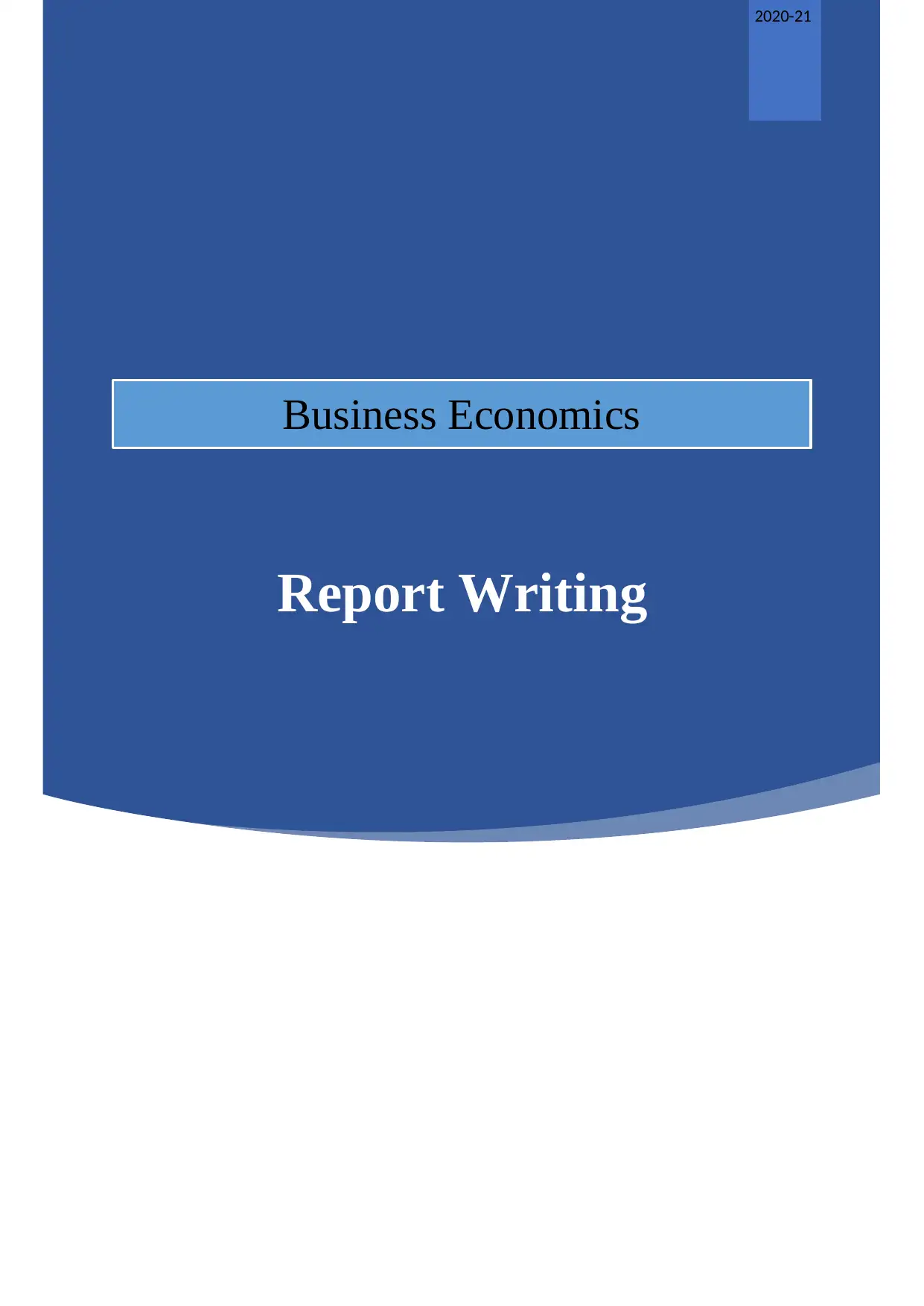
Business Economics
2020-21
Report Writing
2020-21
Report Writing
Paraphrase This Document
Need a fresh take? Get an instant paraphrase of this document with our AI Paraphraser
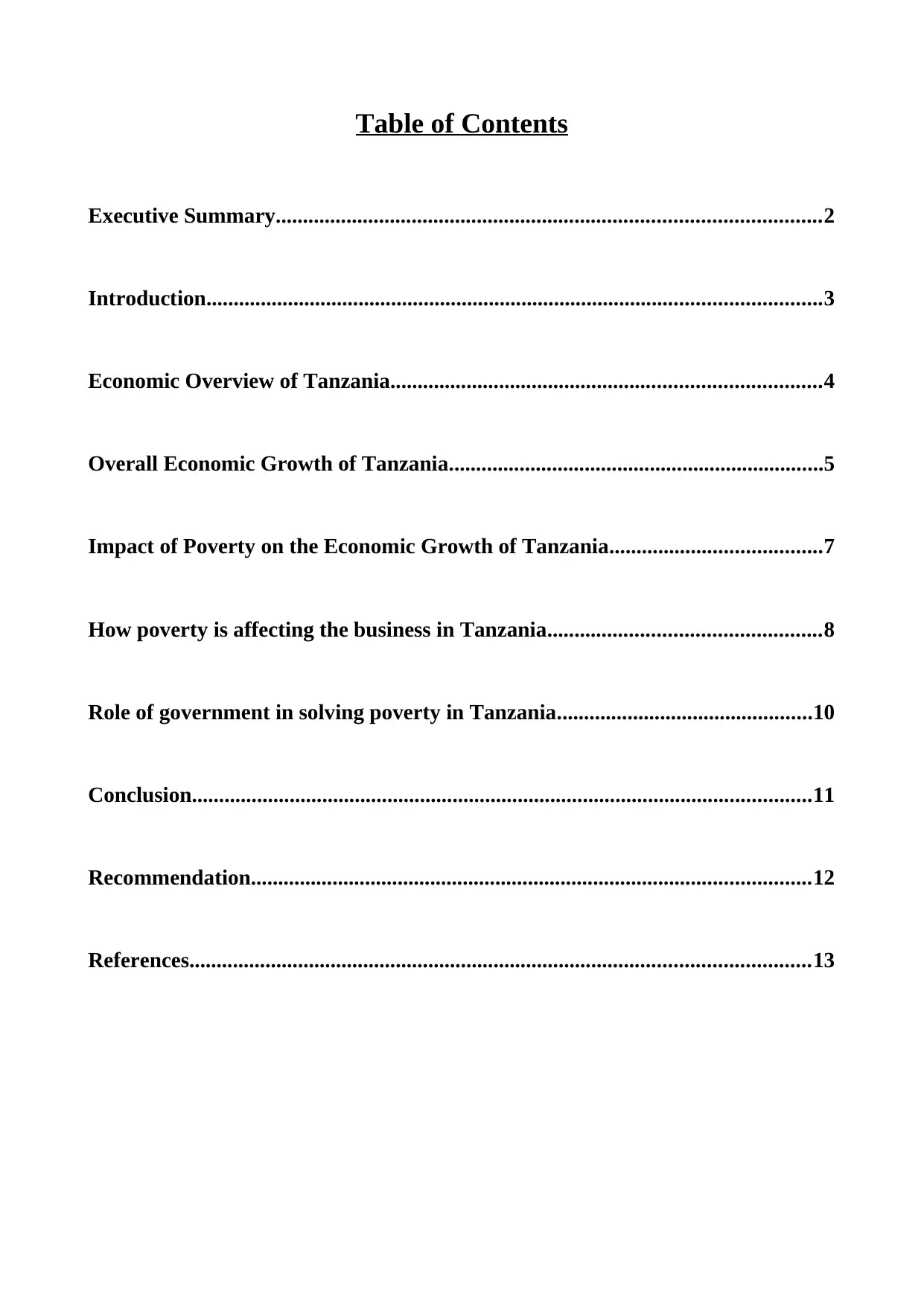
Table of Contents
Executive Summary....................................................................................................2
Introduction.................................................................................................................3
Economic Overview of Tanzania...............................................................................4
Overall Economic Growth of Tanzania.....................................................................5
Impact of Poverty on the Economic Growth of Tanzania.......................................7
How poverty is affecting the business in Tanzania..................................................8
Role of government in solving poverty in Tanzania...............................................10
Conclusion..................................................................................................................11
Recommendation.......................................................................................................12
References..................................................................................................................13
Executive Summary....................................................................................................2
Introduction.................................................................................................................3
Economic Overview of Tanzania...............................................................................4
Overall Economic Growth of Tanzania.....................................................................5
Impact of Poverty on the Economic Growth of Tanzania.......................................7
How poverty is affecting the business in Tanzania..................................................8
Role of government in solving poverty in Tanzania...............................................10
Conclusion..................................................................................................................11
Recommendation.......................................................................................................12
References..................................................................................................................13

1
⊘ This is a preview!⊘
Do you want full access?
Subscribe today to unlock all pages.

Trusted by 1+ million students worldwide
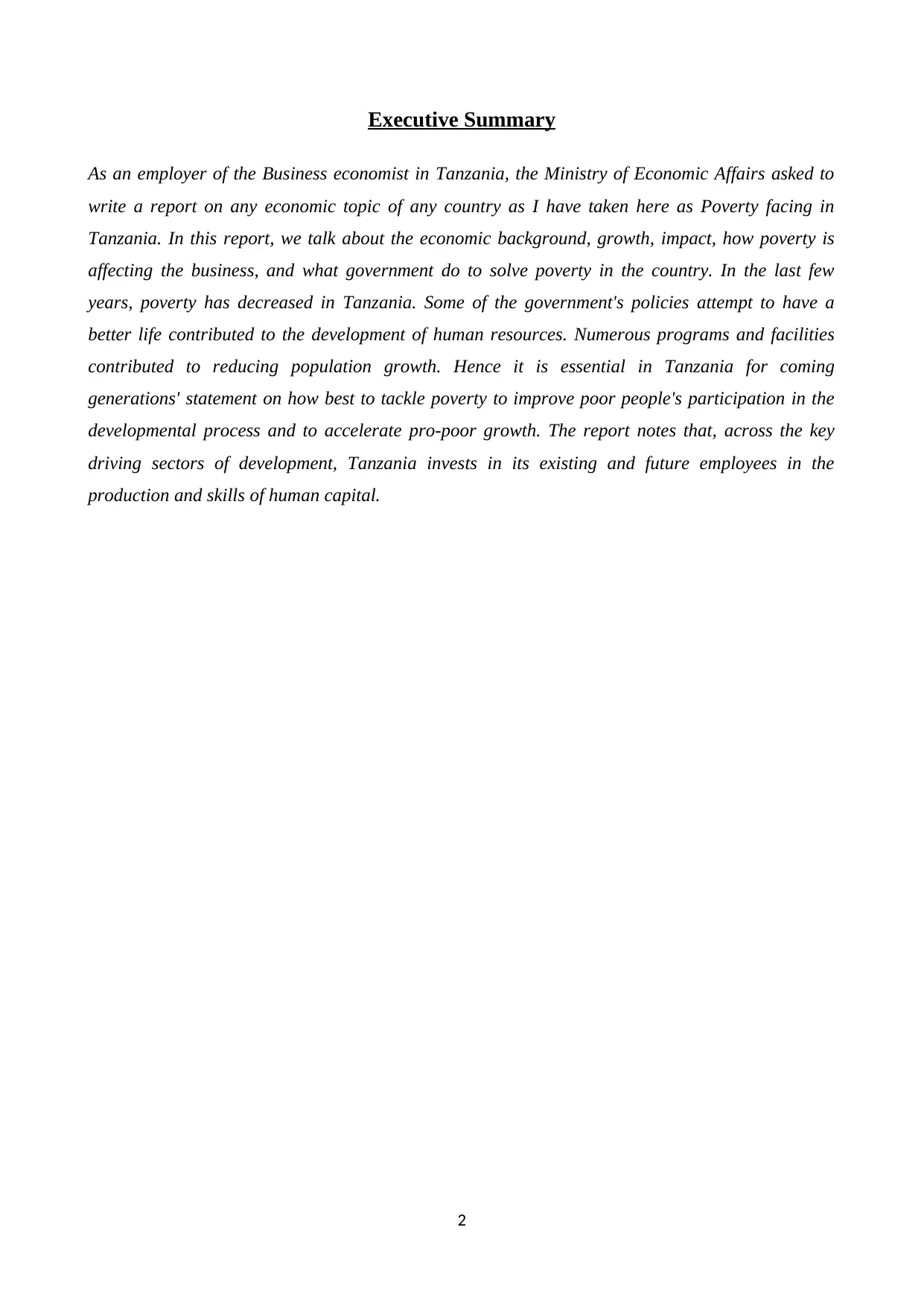
Executive Summary
As an employer of the Business economist in Tanzania, the Ministry of Economic Affairs asked to
write a report on any economic topic of any country as I have taken here as Poverty facing in
Tanzania. In this report, we talk about the economic background, growth, impact, how poverty is
affecting the business, and what government do to solve poverty in the country. In the last few
years, poverty has decreased in Tanzania. Some of the government's policies attempt to have a
better life contributed to the development of human resources. Numerous programs and facilities
contributed to reducing population growth. Hence it is essential in Tanzania for coming
generations' statement on how best to tackle poverty to improve poor people's participation in the
developmental process and to accelerate pro-poor growth. The report notes that, across the key
driving sectors of development, Tanzania invests in its existing and future employees in the
production and skills of human capital.
2
As an employer of the Business economist in Tanzania, the Ministry of Economic Affairs asked to
write a report on any economic topic of any country as I have taken here as Poverty facing in
Tanzania. In this report, we talk about the economic background, growth, impact, how poverty is
affecting the business, and what government do to solve poverty in the country. In the last few
years, poverty has decreased in Tanzania. Some of the government's policies attempt to have a
better life contributed to the development of human resources. Numerous programs and facilities
contributed to reducing population growth. Hence it is essential in Tanzania for coming
generations' statement on how best to tackle poverty to improve poor people's participation in the
developmental process and to accelerate pro-poor growth. The report notes that, across the key
driving sectors of development, Tanzania invests in its existing and future employees in the
production and skills of human capital.
2
Paraphrase This Document
Need a fresh take? Get an instant paraphrase of this document with our AI Paraphraser
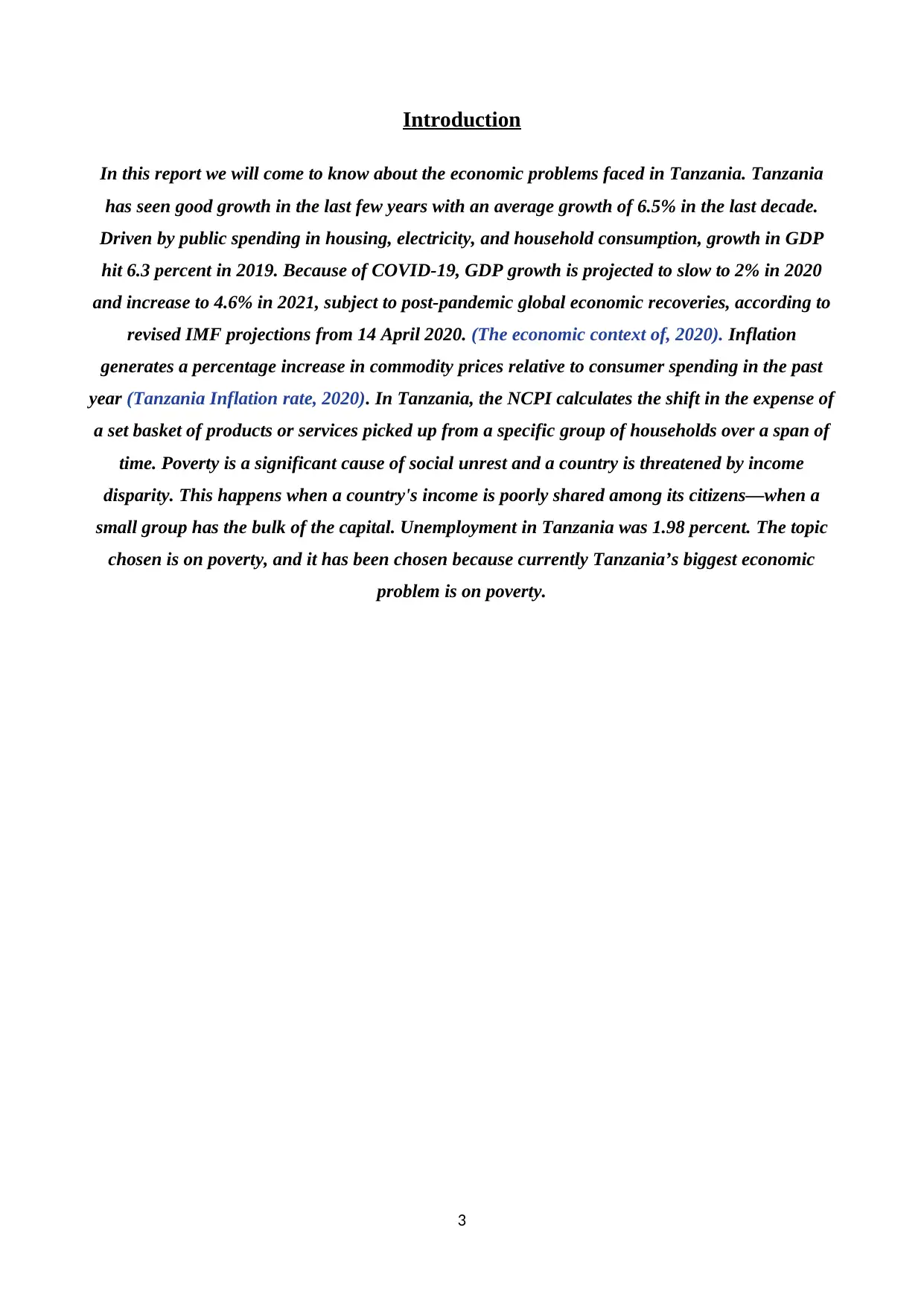
Introduction
In this report we will come to know about the economic problems faced in Tanzania. Tanzania
has seen good growth in the last few years with an average growth of 6.5% in the last decade.
Driven by public spending in housing, electricity, and household consumption, growth in GDP
hit 6.3 percent in 2019. Because of COVID-19, GDP growth is projected to slow to 2% in 2020
and increase to 4.6% in 2021, subject to post-pandemic global economic recoveries, according to
revised IMF projections from 14 April 2020. (The economic context of, 2020). Inflation
generates a percentage increase in commodity prices relative to consumer spending in the past
year (Tanzania Inflation rate, 2020). In Tanzania, the NCPI calculates the shift in the expense of
a set basket of products or services picked up from a specific group of households over a span of
time. Poverty is a significant cause of social unrest and a country is threatened by income
disparity. This happens when a country's income is poorly shared among its citizens—when a
small group has the bulk of the capital. Unemployment in Tanzania was 1.98 percent. The topic
chosen is on poverty, and it has been chosen because currently Tanzania’s biggest economic
problem is on poverty.
3
In this report we will come to know about the economic problems faced in Tanzania. Tanzania
has seen good growth in the last few years with an average growth of 6.5% in the last decade.
Driven by public spending in housing, electricity, and household consumption, growth in GDP
hit 6.3 percent in 2019. Because of COVID-19, GDP growth is projected to slow to 2% in 2020
and increase to 4.6% in 2021, subject to post-pandemic global economic recoveries, according to
revised IMF projections from 14 April 2020. (The economic context of, 2020). Inflation
generates a percentage increase in commodity prices relative to consumer spending in the past
year (Tanzania Inflation rate, 2020). In Tanzania, the NCPI calculates the shift in the expense of
a set basket of products or services picked up from a specific group of households over a span of
time. Poverty is a significant cause of social unrest and a country is threatened by income
disparity. This happens when a country's income is poorly shared among its citizens—when a
small group has the bulk of the capital. Unemployment in Tanzania was 1.98 percent. The topic
chosen is on poverty, and it has been chosen because currently Tanzania’s biggest economic
problem is on poverty.
3
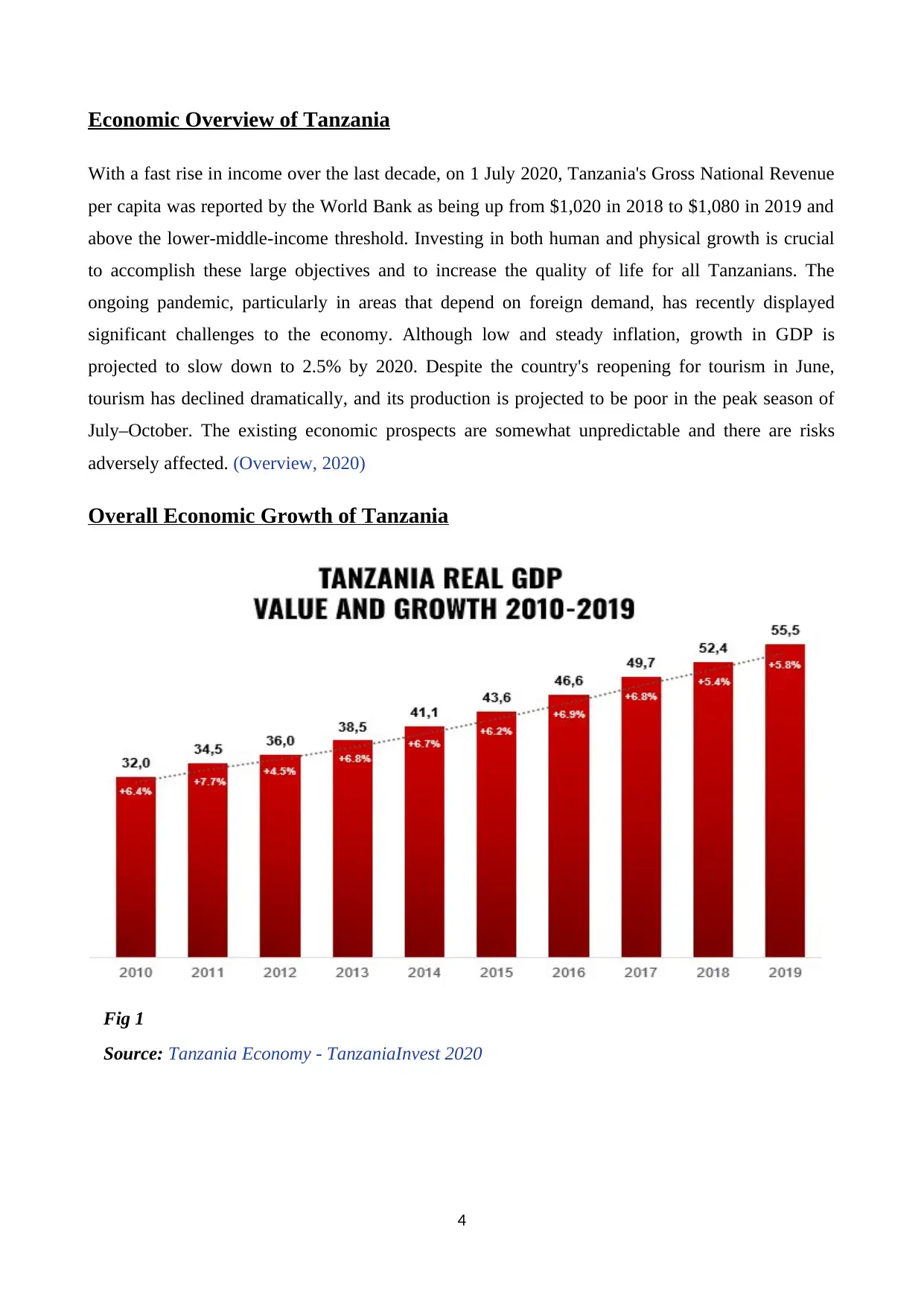
Economic Overview of Tanzania
With a fast rise in income over the last decade, on 1 July 2020, Tanzania's Gross National Revenue
per capita was reported by the World Bank as being up from $1,020 in 2018 to $1,080 in 2019 and
above the lower-middle-income threshold. Investing in both human and physical growth is crucial
to accomplish these large objectives and to increase the quality of life for all Tanzanians. The
ongoing pandemic, particularly in areas that depend on foreign demand, has recently displayed
significant challenges to the economy. Although low and steady inflation, growth in GDP is
projected to slow down to 2.5% by 2020. Despite the country's reopening for tourism in June,
tourism has declined dramatically, and its production is projected to be poor in the peak season of
July–October. The existing economic prospects are somewhat unpredictable and there are risks
adversely affected. (Overview, 2020)
Overall Economic Growth of Tanzania
4
Fig 1
Source: Tanzania Economy - TanzaniaInvest 2020
With a fast rise in income over the last decade, on 1 July 2020, Tanzania's Gross National Revenue
per capita was reported by the World Bank as being up from $1,020 in 2018 to $1,080 in 2019 and
above the lower-middle-income threshold. Investing in both human and physical growth is crucial
to accomplish these large objectives and to increase the quality of life for all Tanzanians. The
ongoing pandemic, particularly in areas that depend on foreign demand, has recently displayed
significant challenges to the economy. Although low and steady inflation, growth in GDP is
projected to slow down to 2.5% by 2020. Despite the country's reopening for tourism in June,
tourism has declined dramatically, and its production is projected to be poor in the peak season of
July–October. The existing economic prospects are somewhat unpredictable and there are risks
adversely affected. (Overview, 2020)
Overall Economic Growth of Tanzania
4
Fig 1
Source: Tanzania Economy - TanzaniaInvest 2020
⊘ This is a preview!⊘
Do you want full access?
Subscribe today to unlock all pages.

Trusted by 1+ million students worldwide

Tanzania has 49% of the people living below the $1.90/day international extreme poverty line.
Also, broad development in labour-intensive industries like agriculture, which hires 77% of adults
in working years, is kept from having poor productivity. The UN Human Development Index of
2017 reports that in Tanzania the unemployment level is 12.9%. Around 49% are working in
Tanzania Medium and big companies comprising 4% of all enterprises. It is expected that 700,000
learners join the labour force in Tanzania per year but in the formal economy only 40,000 find jobs.
Tanzania's companies lead the way in growth through job development, creativity, fiscal income
production, and equal competition. The United States International Development Agency in
Tanzania is trying to produce more sustainable and business-oriented returns through its operations.
USAID aims on raising productivity in rural employment-producing industries while reducing
limits on investment by the private sector in those sectors. (Johnson, 2020)
Impact of Poverty on the Economic Growth of Tanzania
The Tanzanian economy is transformed by modernizing and highly productive agricultural
activities, which are effectively integrated and supported by supporting industrial and service
activities in rural and urban areas. At that point, "Tanzania would have graduated from a less-
developed country to a highly developed middle-income country”. (Jerve and Ofstad, 2000).
However, the extent of the solution to economic growth to poverty reduction depends on how
economic growth is described. The increase elasticity of poverty over the time where economic
growth is described using adjustments measured in the average household consumption.
(TANZANIA MAINLAND POVERTY ASSESSMENT, 2014). Poverty is the state of individuals
who cannot afford life's needs. Labour markets are characterized by wages and demand, which
would contribute to low earnings for certain workers. While extreme poverty studies fear that
agricultural development instantly will not result in a decline in poverty, several surveys say that
reduce poverty in absolute numbers but not in real terms, as the buying power of its relatively low
section has declined. (Pelizzo, Katera, Mwombela and Olan’g, 2018). In many other terms, growth
increased per capita incomes, ensured that more people crossed the poverty line but did not lower
the income inequality. The buying power for 20% of both the Tanzanian population represents,
instead of reflecting on poverty in real terms as expressed by the number of people living in
extreme poverty. The increased demand and output for all sectors is expected to raise incomes by
specializing in households and scaling up output to provide extra room for intermediate products
and production factors. (Kaliba, Mbiha, Nkuba and Kingu, 2020?)
5
Also, broad development in labour-intensive industries like agriculture, which hires 77% of adults
in working years, is kept from having poor productivity. The UN Human Development Index of
2017 reports that in Tanzania the unemployment level is 12.9%. Around 49% are working in
Tanzania Medium and big companies comprising 4% of all enterprises. It is expected that 700,000
learners join the labour force in Tanzania per year but in the formal economy only 40,000 find jobs.
Tanzania's companies lead the way in growth through job development, creativity, fiscal income
production, and equal competition. The United States International Development Agency in
Tanzania is trying to produce more sustainable and business-oriented returns through its operations.
USAID aims on raising productivity in rural employment-producing industries while reducing
limits on investment by the private sector in those sectors. (Johnson, 2020)
Impact of Poverty on the Economic Growth of Tanzania
The Tanzanian economy is transformed by modernizing and highly productive agricultural
activities, which are effectively integrated and supported by supporting industrial and service
activities in rural and urban areas. At that point, "Tanzania would have graduated from a less-
developed country to a highly developed middle-income country”. (Jerve and Ofstad, 2000).
However, the extent of the solution to economic growth to poverty reduction depends on how
economic growth is described. The increase elasticity of poverty over the time where economic
growth is described using adjustments measured in the average household consumption.
(TANZANIA MAINLAND POVERTY ASSESSMENT, 2014). Poverty is the state of individuals
who cannot afford life's needs. Labour markets are characterized by wages and demand, which
would contribute to low earnings for certain workers. While extreme poverty studies fear that
agricultural development instantly will not result in a decline in poverty, several surveys say that
reduce poverty in absolute numbers but not in real terms, as the buying power of its relatively low
section has declined. (Pelizzo, Katera, Mwombela and Olan’g, 2018). In many other terms, growth
increased per capita incomes, ensured that more people crossed the poverty line but did not lower
the income inequality. The buying power for 20% of both the Tanzanian population represents,
instead of reflecting on poverty in real terms as expressed by the number of people living in
extreme poverty. The increased demand and output for all sectors is expected to raise incomes by
specializing in households and scaling up output to provide extra room for intermediate products
and production factors. (Kaliba, Mbiha, Nkuba and Kingu, 2020?)
5
Paraphrase This Document
Need a fresh take? Get an instant paraphrase of this document with our AI Paraphraser
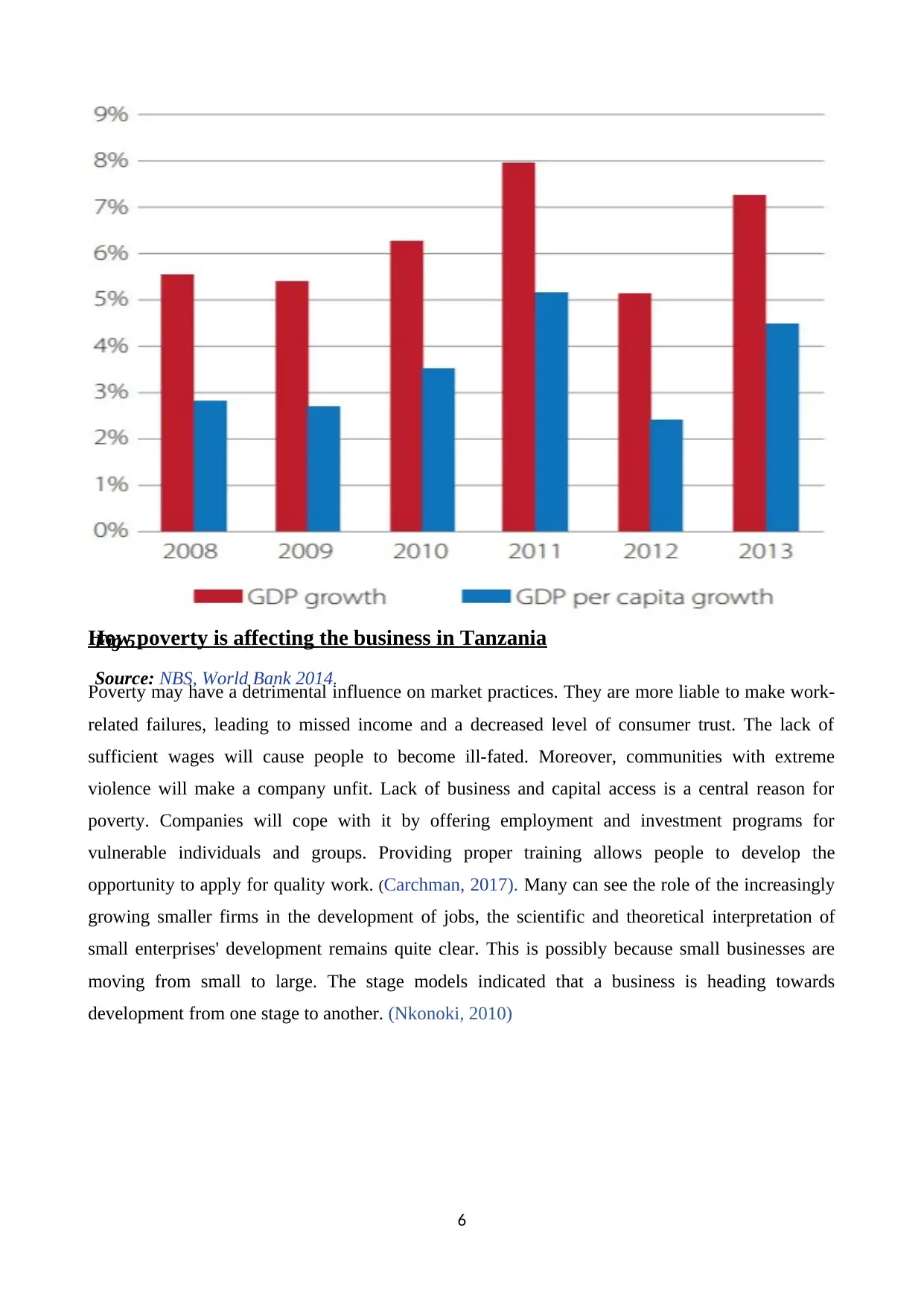
How poverty is affecting the business in Tanzania
Poverty may have a detrimental influence on market practices. They are more liable to make work-
related failures, leading to missed income and a decreased level of consumer trust. The lack of
sufficient wages will cause people to become ill-fated. Moreover, communities with extreme
violence will make a company unfit. Lack of business and capital access is a central reason for
poverty. Companies will cope with it by offering employment and investment programs for
vulnerable individuals and groups. Providing proper training allows people to develop the
opportunity to apply for quality work. (Carchman, 2017). Many can see the role of the increasingly
growing smaller firms in the development of jobs, the scientific and theoretical interpretation of
small enterprises' development remains quite clear. This is possibly because small businesses are
moving from small to large. The stage models indicated that a business is heading towards
development from one stage to another. (Nkonoki, 2010)
6
Fig 5
Source: NBS, World Bank 2014.
Poverty may have a detrimental influence on market practices. They are more liable to make work-
related failures, leading to missed income and a decreased level of consumer trust. The lack of
sufficient wages will cause people to become ill-fated. Moreover, communities with extreme
violence will make a company unfit. Lack of business and capital access is a central reason for
poverty. Companies will cope with it by offering employment and investment programs for
vulnerable individuals and groups. Providing proper training allows people to develop the
opportunity to apply for quality work. (Carchman, 2017). Many can see the role of the increasingly
growing smaller firms in the development of jobs, the scientific and theoretical interpretation of
small enterprises' development remains quite clear. This is possibly because small businesses are
moving from small to large. The stage models indicated that a business is heading towards
development from one stage to another. (Nkonoki, 2010)
6
Fig 5
Source: NBS, World Bank 2014.
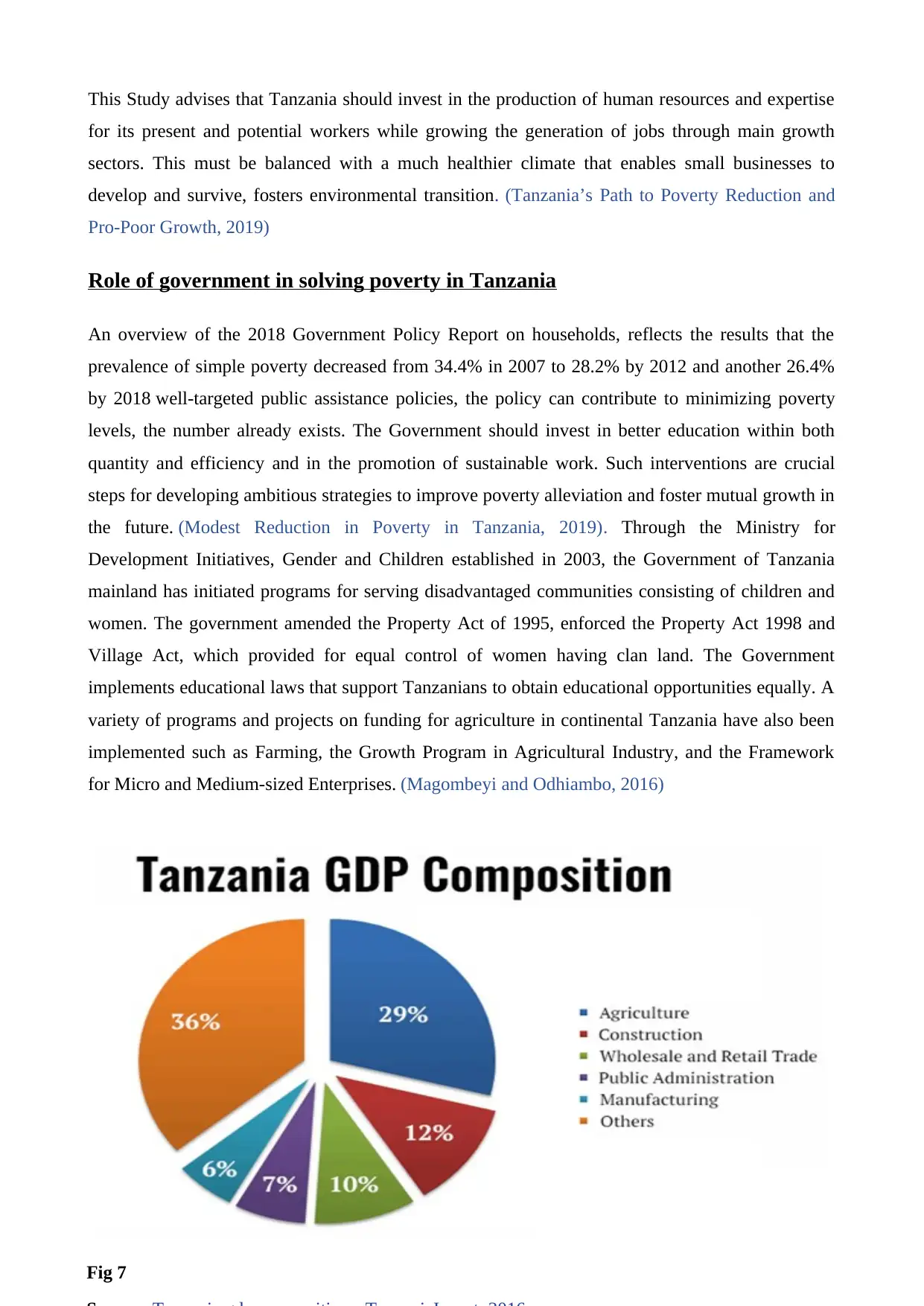
This Study advises that Tanzania should invest in the production of human resources and expertise
for its present and potential workers while growing the generation of jobs through main growth
sectors. This must be balanced with a much healthier climate that enables small businesses to
develop and survive, fosters environmental transition. (Tanzania’s Path to Poverty Reduction and
Pro-Poor Growth, 2019)
Role of government in solving poverty in Tanzania
An overview of the 2018 Government Policy Report on households, reflects the results that the
prevalence of simple poverty decreased from 34.4% in 2007 to 28.2% by 2012 and another 26.4%
by 2018 well-targeted public assistance policies, the policy can contribute to minimizing poverty
levels, the number already exists. The Government should invest in better education within both
quantity and efficiency and in the promotion of sustainable work. Such interventions are crucial
steps for developing ambitious strategies to improve poverty alleviation and foster mutual growth in
the future. (Modest Reduction in Poverty in Tanzania, 2019). Through the Ministry for
Development Initiatives, Gender and Children established in 2003, the Government of Tanzania
mainland has initiated programs for serving disadvantaged communities consisting of children and
women. The government amended the Property Act of 1995, enforced the Property Act 1998 and
Village Act, which provided for equal control of women having clan land. The Government
implements educational laws that support Tanzanians to obtain educational opportunities equally. A
variety of programs and projects on funding for agriculture in continental Tanzania have also been
implemented such as Farming, the Growth Program in Agricultural Industry, and the Framework
for Micro and Medium-sized Enterprises. (Magombeyi and Odhiambo, 2016)
7
Fig 7
for its present and potential workers while growing the generation of jobs through main growth
sectors. This must be balanced with a much healthier climate that enables small businesses to
develop and survive, fosters environmental transition. (Tanzania’s Path to Poverty Reduction and
Pro-Poor Growth, 2019)
Role of government in solving poverty in Tanzania
An overview of the 2018 Government Policy Report on households, reflects the results that the
prevalence of simple poverty decreased from 34.4% in 2007 to 28.2% by 2012 and another 26.4%
by 2018 well-targeted public assistance policies, the policy can contribute to minimizing poverty
levels, the number already exists. The Government should invest in better education within both
quantity and efficiency and in the promotion of sustainable work. Such interventions are crucial
steps for developing ambitious strategies to improve poverty alleviation and foster mutual growth in
the future. (Modest Reduction in Poverty in Tanzania, 2019). Through the Ministry for
Development Initiatives, Gender and Children established in 2003, the Government of Tanzania
mainland has initiated programs for serving disadvantaged communities consisting of children and
women. The government amended the Property Act of 1995, enforced the Property Act 1998 and
Village Act, which provided for equal control of women having clan land. The Government
implements educational laws that support Tanzanians to obtain educational opportunities equally. A
variety of programs and projects on funding for agriculture in continental Tanzania have also been
implemented such as Farming, the Growth Program in Agricultural Industry, and the Framework
for Micro and Medium-sized Enterprises. (Magombeyi and Odhiambo, 2016)
7
Fig 7
⊘ This is a preview!⊘
Do you want full access?
Subscribe today to unlock all pages.

Trusted by 1+ million students worldwide
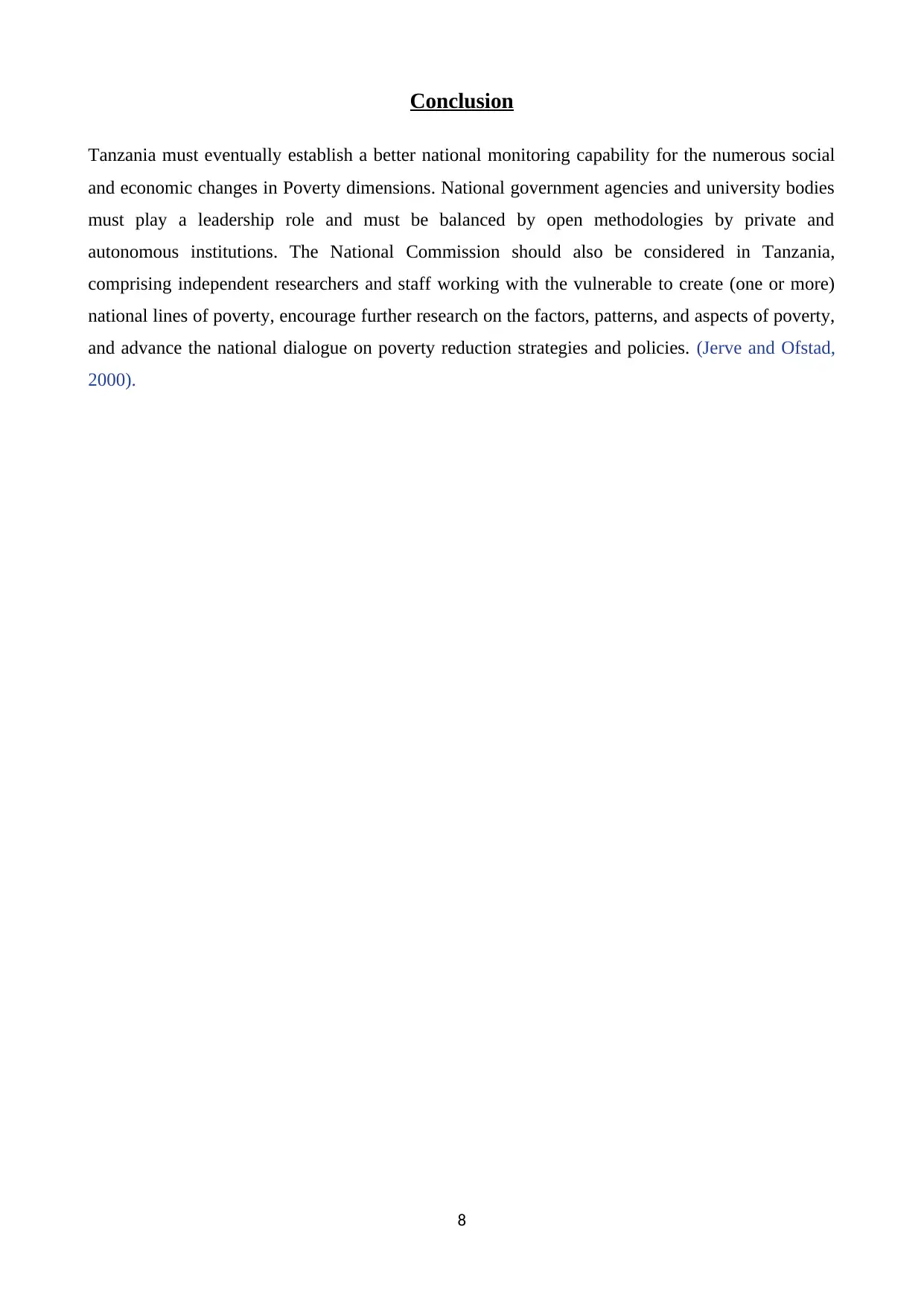
Conclusion
Tanzania must eventually establish a better national monitoring capability for the numerous social
and economic changes in Poverty dimensions. National government agencies and university bodies
must play a leadership role and must be balanced by open methodologies by private and
autonomous institutions. The National Commission should also be considered in Tanzania,
comprising independent researchers and staff working with the vulnerable to create (one or more)
national lines of poverty, encourage further research on the factors, patterns, and aspects of poverty,
and advance the national dialogue on poverty reduction strategies and policies. (Jerve and Ofstad,
2000).
8
Tanzania must eventually establish a better national monitoring capability for the numerous social
and economic changes in Poverty dimensions. National government agencies and university bodies
must play a leadership role and must be balanced by open methodologies by private and
autonomous institutions. The National Commission should also be considered in Tanzania,
comprising independent researchers and staff working with the vulnerable to create (one or more)
national lines of poverty, encourage further research on the factors, patterns, and aspects of poverty,
and advance the national dialogue on poverty reduction strategies and policies. (Jerve and Ofstad,
2000).
8
Paraphrase This Document
Need a fresh take? Get an instant paraphrase of this document with our AI Paraphraser
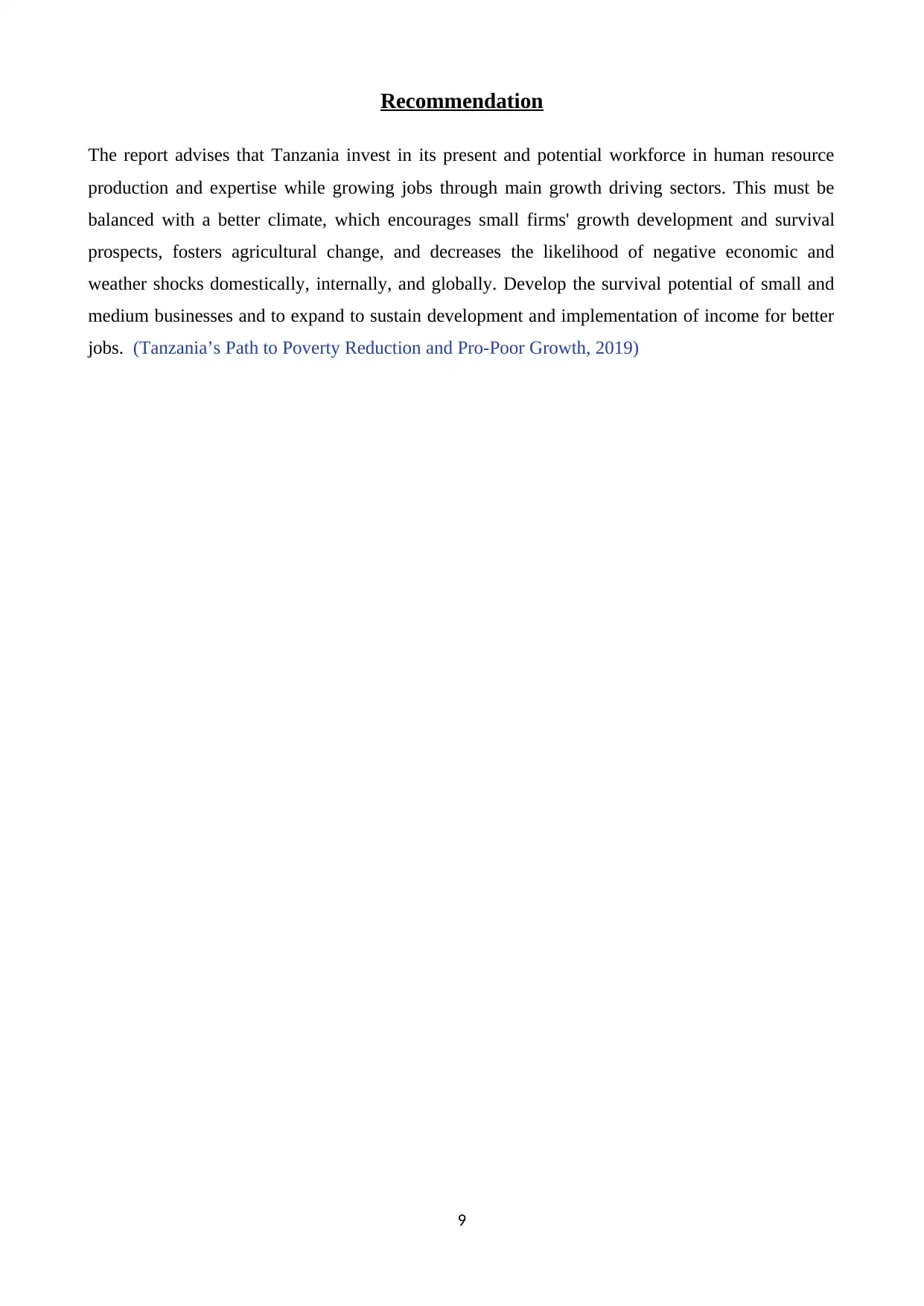
Recommendation
The report advises that Tanzania invest in its present and potential workforce in human resource
production and expertise while growing jobs through main growth driving sectors. This must be
balanced with a better climate, which encourages small firms' growth development and survival
prospects, fosters agricultural change, and decreases the likelihood of negative economic and
weather shocks domestically, internally, and globally. Develop the survival potential of small and
medium businesses and to expand to sustain development and implementation of income for better
jobs. (Tanzania’s Path to Poverty Reduction and Pro-Poor Growth, 2019)
9
The report advises that Tanzania invest in its present and potential workforce in human resource
production and expertise while growing jobs through main growth driving sectors. This must be
balanced with a better climate, which encourages small firms' growth development and survival
prospects, fosters agricultural change, and decreases the likelihood of negative economic and
weather shocks domestically, internally, and globally. Develop the survival potential of small and
medium businesses and to expand to sustain development and implementation of income for better
jobs. (Tanzania’s Path to Poverty Reduction and Pro-Poor Growth, 2019)
9
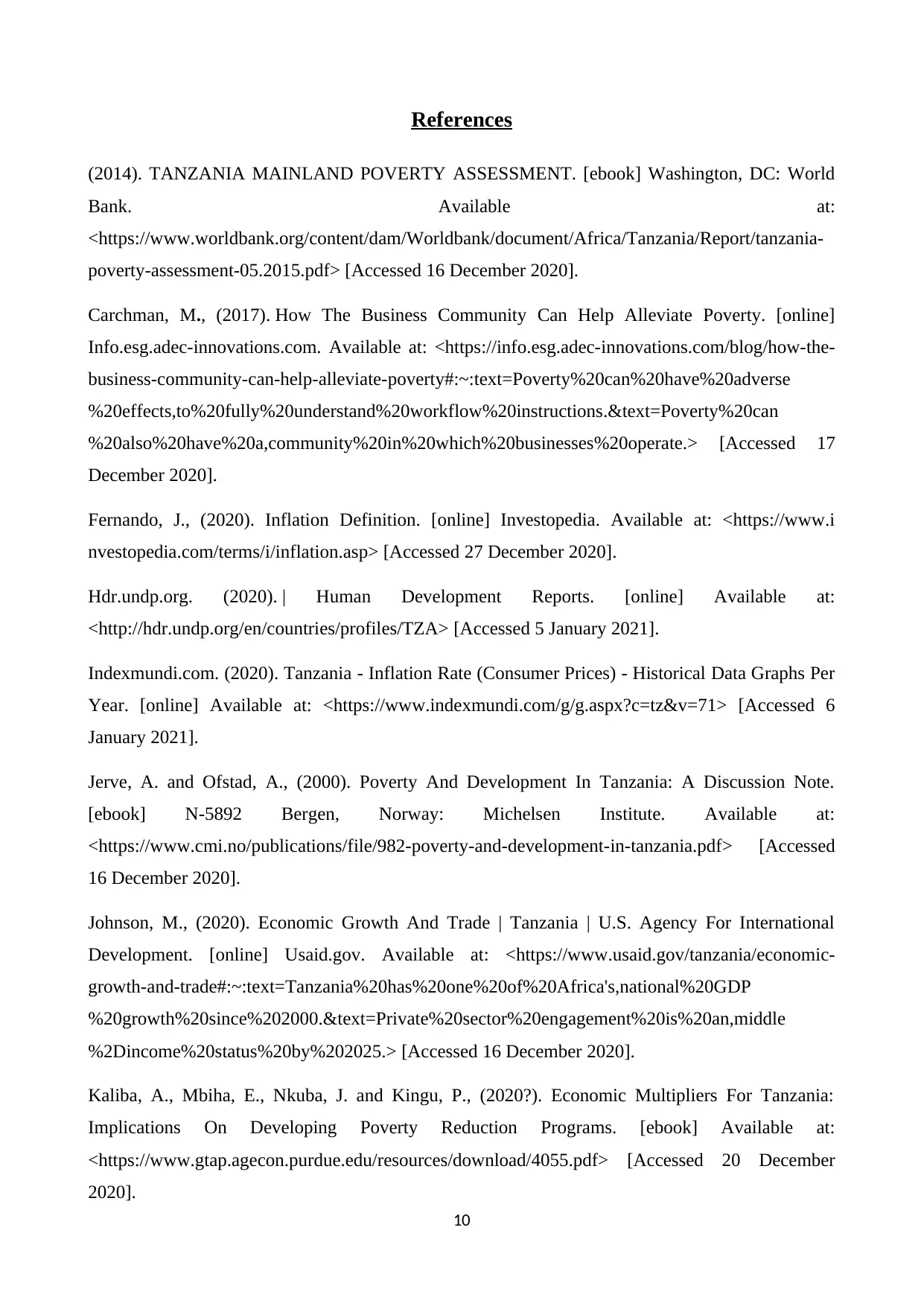
References
(2014). TANZANIA MAINLAND POVERTY ASSESSMENT. [ebook] Washington, DC: World
Bank. Available at:
<https://www.worldbank.org/content/dam/Worldbank/document/Africa/Tanzania/Report/tanzania-
poverty-assessment-05.2015.pdf> [Accessed 16 December 2020].
Carchman, M., (2017). How The Business Community Can Help Alleviate Poverty. [online]
Info.esg.adec-innovations.com. Available at: <https://info.esg.adec-innovations.com/blog/how-the-
business-community-can-help-alleviate-poverty#:~:text=Poverty%20can%20have%20adverse
%20effects,to%20fully%20understand%20workflow%20instructions.&text=Poverty%20can
%20also%20have%20a,community%20in%20which%20businesses%20operate.> [Accessed 17
December 2020].
Fernando, J., (2020). Inflation Definition. [online] Investopedia. Available at: <https://www.i
nvestopedia.com/terms/i/inflation.asp> [Accessed 27 December 2020].
Hdr.undp.org. (2020). | Human Development Reports. [online] Available at:
<http://hdr.undp.org/en/countries/profiles/TZA> [Accessed 5 January 2021].
Indexmundi.com. (2020). Tanzania - Inflation Rate (Consumer Prices) - Historical Data Graphs Per
Year. [online] Available at: <https://www.indexmundi.com/g/g.aspx?c=tz&v=71> [Accessed 6
January 2021].
Jerve, A. and Ofstad, A., (2000). Poverty And Development In Tanzania: A Discussion Note.
[ebook] N-5892 Bergen, Norway: Michelsen Institute. Available at:
<https://www.cmi.no/publications/file/982-poverty-and-development-in-tanzania.pdf> [Accessed
16 December 2020].
Johnson, M., (2020). Economic Growth And Trade | Tanzania | U.S. Agency For International
Development. [online] Usaid.gov. Available at: <https://www.usaid.gov/tanzania/economic-
growth-and-trade#:~:text=Tanzania%20has%20one%20of%20Africa's,national%20GDP
%20growth%20since%202000.&text=Private%20sector%20engagement%20is%20an,middle
%2Dincome%20status%20by%202025.> [Accessed 16 December 2020].
Kaliba, A., Mbiha, E., Nkuba, J. and Kingu, P., (2020?). Economic Multipliers For Tanzania:
Implications On Developing Poverty Reduction Programs. [ebook] Available at:
<https://www.gtap.agecon.purdue.edu/resources/download/4055.pdf> [Accessed 20 December
2020].
10
(2014). TANZANIA MAINLAND POVERTY ASSESSMENT. [ebook] Washington, DC: World
Bank. Available at:
<https://www.worldbank.org/content/dam/Worldbank/document/Africa/Tanzania/Report/tanzania-
poverty-assessment-05.2015.pdf> [Accessed 16 December 2020].
Carchman, M., (2017). How The Business Community Can Help Alleviate Poverty. [online]
Info.esg.adec-innovations.com. Available at: <https://info.esg.adec-innovations.com/blog/how-the-
business-community-can-help-alleviate-poverty#:~:text=Poverty%20can%20have%20adverse
%20effects,to%20fully%20understand%20workflow%20instructions.&text=Poverty%20can
%20also%20have%20a,community%20in%20which%20businesses%20operate.> [Accessed 17
December 2020].
Fernando, J., (2020). Inflation Definition. [online] Investopedia. Available at: <https://www.i
nvestopedia.com/terms/i/inflation.asp> [Accessed 27 December 2020].
Hdr.undp.org. (2020). | Human Development Reports. [online] Available at:
<http://hdr.undp.org/en/countries/profiles/TZA> [Accessed 5 January 2021].
Indexmundi.com. (2020). Tanzania - Inflation Rate (Consumer Prices) - Historical Data Graphs Per
Year. [online] Available at: <https://www.indexmundi.com/g/g.aspx?c=tz&v=71> [Accessed 6
January 2021].
Jerve, A. and Ofstad, A., (2000). Poverty And Development In Tanzania: A Discussion Note.
[ebook] N-5892 Bergen, Norway: Michelsen Institute. Available at:
<https://www.cmi.no/publications/file/982-poverty-and-development-in-tanzania.pdf> [Accessed
16 December 2020].
Johnson, M., (2020). Economic Growth And Trade | Tanzania | U.S. Agency For International
Development. [online] Usaid.gov. Available at: <https://www.usaid.gov/tanzania/economic-
growth-and-trade#:~:text=Tanzania%20has%20one%20of%20Africa's,national%20GDP
%20growth%20since%202000.&text=Private%20sector%20engagement%20is%20an,middle
%2Dincome%20status%20by%202025.> [Accessed 16 December 2020].
Kaliba, A., Mbiha, E., Nkuba, J. and Kingu, P., (2020?). Economic Multipliers For Tanzania:
Implications On Developing Poverty Reduction Programs. [ebook] Available at:
<https://www.gtap.agecon.purdue.edu/resources/download/4055.pdf> [Accessed 20 December
2020].
10
⊘ This is a preview!⊘
Do you want full access?
Subscribe today to unlock all pages.

Trusted by 1+ million students worldwide
1 out of 13
Related Documents
Your All-in-One AI-Powered Toolkit for Academic Success.
+13062052269
info@desklib.com
Available 24*7 on WhatsApp / Email
![[object Object]](/_next/static/media/star-bottom.7253800d.svg)
Unlock your academic potential
Copyright © 2020–2025 A2Z Services. All Rights Reserved. Developed and managed by ZUCOL.





